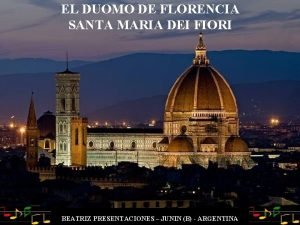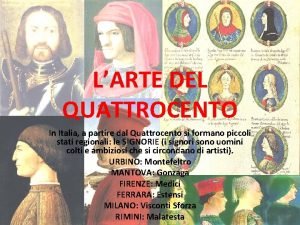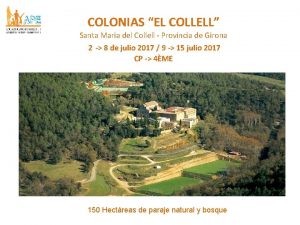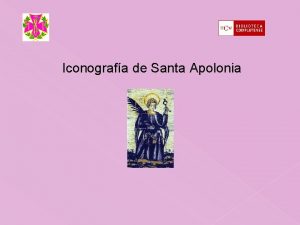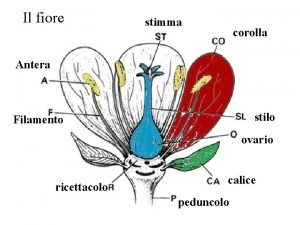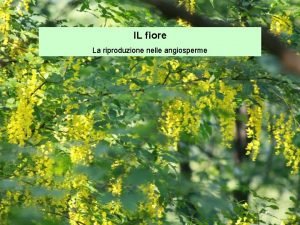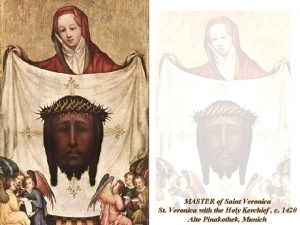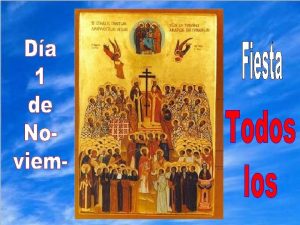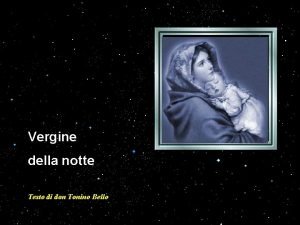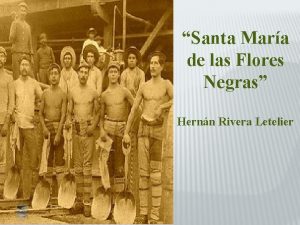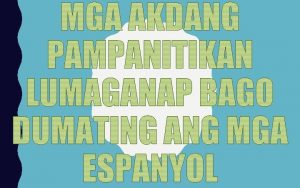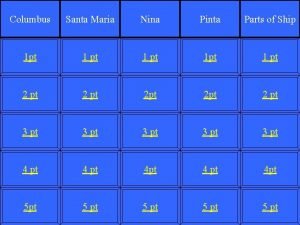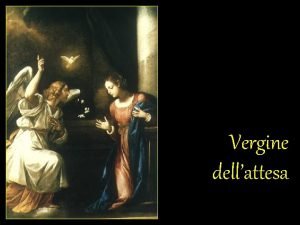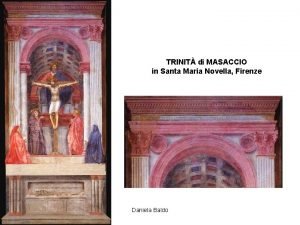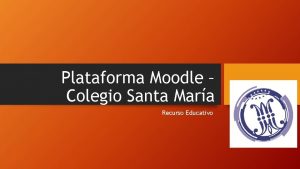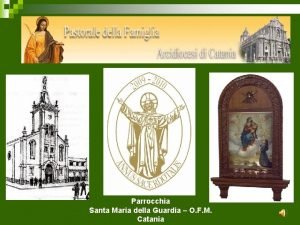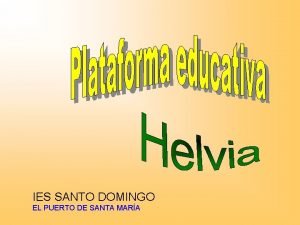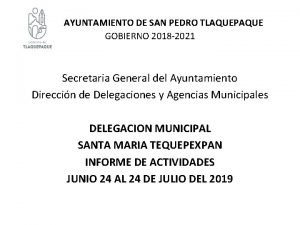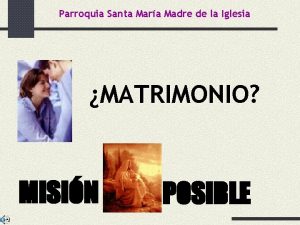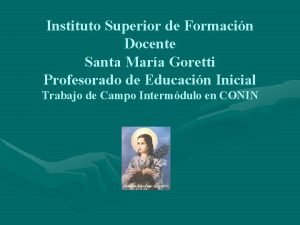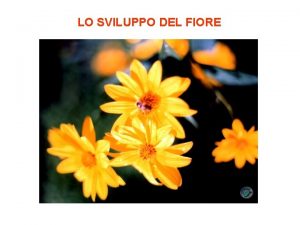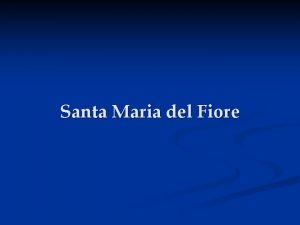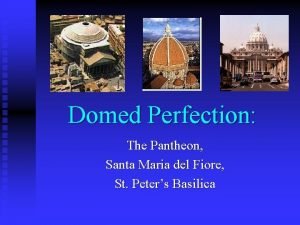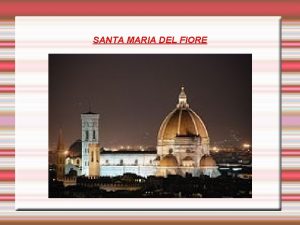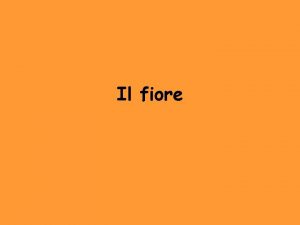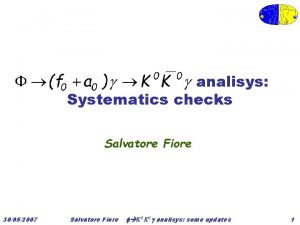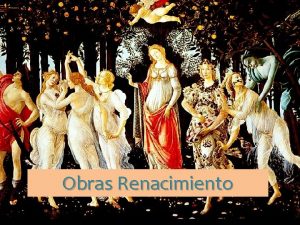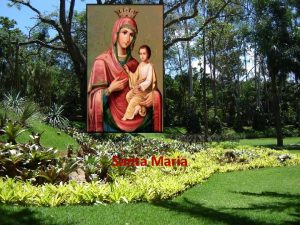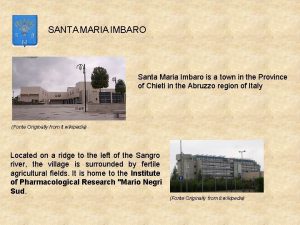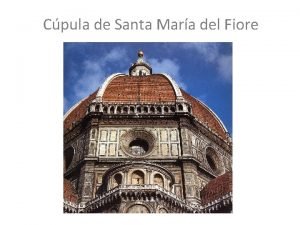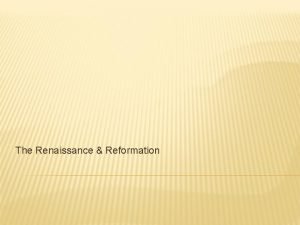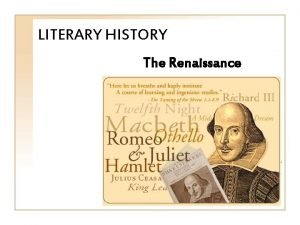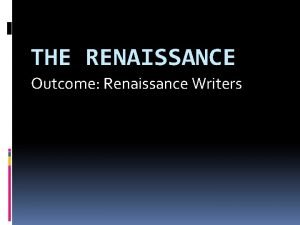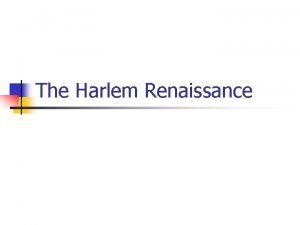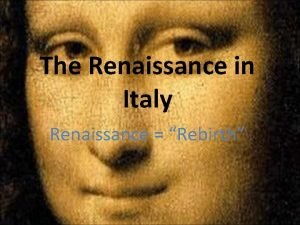MODULE 7 Renaissance Architecture Santa Maria del Fiore























- Slides: 23

MODULE 7 – Renaissance Architecture Santa Maria del Fiore, Florence, ITALY, 1294 -1436.

This Week’s Agenda: Recap of Islamic Architecture Mid-term correction Major Project brainstorming MODULE 7 – Renaissance Handout Assignment 4 Glossary Exercise ‘The Sun does not realise how wonderful it is until after a room is made. ’ - Louis Kahn (1901 -1974)

Major Project Brainstorming Based on the feedback that we received as part of the mid-term, we would like to ask you to think about what your Major Project should be in Architectural History. Some of the things that were mentioned are: • More sketching, field trips, quizzes, images, handouts, comparisons, presentations, in-class exercises, videos, snacks…. • A deeper look at other types of architecture, such as Chinese, Japanese, contemporary, etc. In teams of 4, prepare a potential Major Project exercise for the class to complete. It MUST include: • A presentation • A written component, including research/case-study • Remember, the Major Project is worth 20% of your final grade Other than that, it’s up to you! Get creative and have fun! Upload your potential project to the Shared Page indicated by your instructor. Maybe, just maybe, yours will be the one selected this year!

The Age of Decadence Gothic: approximately 1100 to 1400 AD Renaissance: approximately 1400 to 1600 AD Black Death – peaked in 1348 in Europe, spread due to trade/conquests/exploration between areas – on ticks. • Wiped out up to 60% of people in certain parts of Europe • Many of the Master Builders died = loss of knowledge

Escape from the Dark Ages THE RESULT: The middle class rose up and there was a rebirth Rebirth = RENAISSANCE! Rebirth of what? • A return to the glory of Ancient Roman culture • A return to philosophy, mathematics and geometry – see the Vitruvian Man, Man within a Square and a Circle The square represents the Earth The circle represents the Cosmos = The Divine Beauty of God in conjunction with Man Beauty offers a glimpse to the Heavens!

How did we get from Gothic to Renaissance? In the middle ages, representations were flat… • Child looks flat • No depth to the work • There seems to be very little space between the figures and viewer Cimabue: Madonna Enthroned with the Child, c. 1260

How did we get from Gothic to Renaissance? Giotto introduces depth… The architecture of the throne helps Giotto show perspective Giotto: Madonna Enthroned, 1310. Cimabue: Madonna Enthroned with the Child, c. 1260

How did we get from Gothic to Renaissance? Giotto explores depth with his placement of characters and “architectural features” such as the low wall… The converging wedge of the placement of the angels show depth. Giotto: The Lamentation, 1304 -06

How did we get from Gothic to Renaissance? BAPTISTERY of San Giovanni 1059 to 1128 Romanesque BELL TOWER by Giotto Completed in 1359 Gothic DOME by Brunelleschi 1296 -1469 Renaissance

The Turning Point A competition to construct the bronze doors for the baptistery at San Giovanni in Florence. Baptistery of San Giovanni (St-John), 1059 to 1128 • Romanesque style • Important influence on Renaissance architects

The Turning Point South Doors Andrea da Pisano 1330 -1336 = FLAT East Doors Lorenzo Ghiberti 1378 -1455 = DIMENSIONAL SPACE

The Turning Point Brunelleschi’s lost made him focus in other pursuit than sculpture turning into the study of architecture https: //www. youtube. com/watch? v=uvg. BSJPi. Q 8 Y

The Proof is in the Pudding? No… the Perspective! Brunelleschi wants to further the idea of perspective by proving it mathematically. He does so by drawing the baptistery in perspective. People can’t tell if they are looking directly at the Baptistry (A) or the drawings of it (B)

The Dome of Santa Maria del Fiore Let’s watch this video on the construction of the dome: https: //www. youtube. com/watch? v=_IOPl. GPQPu. M

Leonbattista Alberti De re aedificatoria 1452, “ 10 Books on Architecture” According to Alberti, beauty is: • proportion, • it is nature • it is perceived intuitively • the numbers and proportions given to us by the Ancient cultures are authority. There are two TYPES of beauty: • Venustas, is feminine = light hearted • Dignitas, is masculine = serious

Leonbattista Alberti • • • The CIRCLE and the SQUARE are very important to Alberti in terms of church design. He, and many others in Renaissance, believe in centralized plans, but they don’t work as well as the cruciform plan. WHY? ? They believe that these forms represent the geometric plans of the cosmic orders. The Tempietto, Rome, 1502 by Bramante Michelangelo’s plan for Saint Peter’s Basilica in Rome.

In-class exercise As a table of 4, prepare a 2 -minute presentation of the key principles of the following Renaissance buildings by these two Masters: Brunelleschi: • San Lorenzo • Ospedale degli Innocenti • Santo Spirito • Pazzi Chapel • Santa Croce • Florence Cathedral • Palazzo Pitti o o o Alberti: • Santa Maria Novella • San Francesco at Rimini – Tempio Malatestiano • Palazzo Rucellai • San Andrea at Mantua • San Sebastiano • Old St-Peter’s Basilica What can you say about its geometry? Are there references to Ancient Roman shapes/imagery? Have you shown its plan? Have you shown its elevation? Have you shown an interior shot? Please use a max of 2 slides in our shared Power Point YOU WILL BE STOPPED AT 2 MINUTES!

Find the geometric patterns in the following building listed in this Power. Point Use the geometric ratios provided by superimposing it to the Plans / elevations / sections of the building o What can you say about its geometry?

ASSIGNMENT 4 Spaghetti Tower Challenge The study of the history of architecture exposes us to beautifully designed and built structures. Some structures reach for the skies and take pride in being the tallest and aesthetically beautiful building in the world. Using 40 spaghetti sticks and glue, create the tallest and / or most aesthetically pleasing structure possible. The building should be at least 2 spaghetti sticks high and incorporate design principles learned in class. sheridancollege. ca

ASSIGNMENT 4 Spaghetti Tower Challenge Requirements Documentation: Document the thought process you went through in defining the problem using the handout. Do research for solutions and analyze what you can use for the assigned model. Remember that you need to make the tallest and / or most beautiful spaghetti structure. You will need to test your ideas. Take pictures of your successes and even failures as you try different approaches to the solution of a balanced, tall and beautiful structure. Share your ideas and get some feedback so that you can improve on the initial design. Write-up a two page report on the whole process. Be sure to cite your references on a separate sheet using the APA style learned in class sheridancollege. ca

ASSIGNMENT 4 Spaghetti Tower Challenge Rubrics Marks and Bonus Marks 1) Tallest structure: The tallest free-standing structure measured in class will get a bonus mark of 10 points. The Second tallest gets a 5 bonus mark and the third tallest gets a 3 bonus mark on their grade. Structures not meeting the 2 spaghetti high mark get a 25 point deduction from their grade. 2) Most Aesthetically pleasing design: The structure that is voted as the most aesthetically pleasing by the judges assembled by the instructor will get 15 bonus marks. Only one winner will be proclaimed under this category. Good luck! sheridancollege. ca

RUBRICS Spaghetti Tower Challenge Excellent (25) Above Ave. (20) Average (15) Good (10) Poor (5) N / S (0) Structural Design Used 40 or less spaghetti sticks glued together to form a very stable structural form Used 40 or less spaghetti sticks glued together to form a somewhat stable structural form Used more than 40 spaghetti sticks glued together form a stable structural form Structure is not so stable Structural failure of the tower No Submission Aesthetic Design Used 40 or less spaghetti sticks, neatly glued together, applying 1 or more design principle evident in the structure Used 40 or less spaghetti sticks, glued together, applying 1 or more design principle evident in the structure Used more than 40 spaghetti sticks, glued together, applying 1 or more design principle evident in the structure Design intention is not evident in the structure Does not adhere to any design principle No Submission Spaghetti Tower Problem analysis Properly identified analyzed the design and transportation issues of the challenge using references to other solutions to similar challenges Properly identified analyzed most of the design and transportation issues of the challenge using references to other solutions to similar challenges Identified analyzed most of the design and transportation issues of the challenge A simple narrative on the design and or transportation issue was discussed Little to no analysis was done regarding the spaghetti tower problem No Submission Design and construction documentation Extensive documentation on the various stages of the design, construction and transportation of the tower Complete documentation on the various stages of the design, construction and transportation of the tower was provided Substantial documentation on the various stages of the design, construction and transportation of the tower Documentation on the various stages of the design, construction and transportation of the tower was provided Little or no documentation done on the progress of the conceptualization to construction of the tower No Submission sheridancollege. ca

In-class exercise As a table of 4, brainstorm 12 UNIQUE terms to add to our Glossary of Architectural Terms. (This can be done on the board or in a shared Excel spreadsheet. Once every person in the class has at least 1 unique word, add it, with a description and a photo that explains it to our shared Excel document. We will add all of the terms that you come up with to our Glossary. If time permits, add as many words as you can. The student with the most COMPLETED definitions that are accurate, correct and pertinent to this class will receive a 2 -mark bonus to be applied to the assignment of their choice.
 Santa maria dei fiori
Santa maria dei fiori Calotte cupola santa maria del fiore
Calotte cupola santa maria del fiore Santa maria del collell
Santa maria del collell Santa apolonia santa rosa
Santa apolonia santa rosa Ovario del fiore
Ovario del fiore Parti del giglio
Parti del giglio La ginestra o il fiore del deserto
La ginestra o il fiore del deserto Il fiore e la riproduzione
Il fiore e la riproduzione Santa maria madre de dios rosario
Santa maria madre de dios rosario Veronica
Veronica Cuerpo incorrupto santa maría goretti
Cuerpo incorrupto santa maría goretti Madre maria helena cavalcanti
Madre maria helena cavalcanti Vergine della notte don tonino bello
Vergine della notte don tonino bello Santa maria de las flores negras
Santa maria de las flores negras 20 halimbawa ng idyoma at gamitin sa pangungusap
20 halimbawa ng idyoma at gamitin sa pangungusap Santa maria pinta ja nina
Santa maria pinta ja nina Maria vergine dell'attesa
Maria vergine dell'attesa Masaccio santa maria novella
Masaccio santa maria novella Moodle colegio morelos
Moodle colegio morelos Santa maria della guardia
Santa maria della guardia Ies santo domingo el puerto de santa maria
Ies santo domingo el puerto de santa maria Delegacion santa maria tequepexpan
Delegacion santa maria tequepexpan Parroquia santa maria madre de la iglesia
Parroquia santa maria madre de la iglesia Instituto superior de formacion docente santa maria
Instituto superior de formacion docente santa maria
